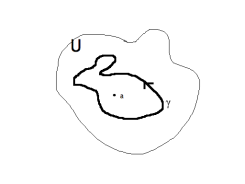Fundamental theorem of algebra
July 27, 2012 Leave a comment
I really think this is a misnomer. The theorem has very little to do with algebra. The theorem, is an assertion about the complex numbers which are very much an analytic object. Anyway, the proof is pretty short, so here goes.
Theorem 1 Every polynomial with coefficients in
has at least one root in
.
Proof: Let be a non-constant polynomial. Assume for the sake of contradiction that
has no roots in
. Then indeed, there is some small open set in
that must not be in the image of
. Why? If
assuming
, then
so for far enough away from zero,
must be close to
. In particular, for large enough
we can make
at least
. Hence,
must be, (for large
), at least
, and hence, far away from zero. Let
be any such value which is large enough to guarantee that for
, we have the result just described.
But what about the small complex numbers? Couldn’t those get close to zero? Alas, no. the set is compact, and so if
gets arbitrarily close to zero on this set, it in fact hits zero. By assumption,
is never zero, and so it must be bounded away from zero. So let’s say that if
, then
is not in the image of
. In other words, for each
,
.
Now if is never zero, then
is defined on all of
. But remember that
. This means that
. But now
is bounded and entire (holomorphic on all of
), so
must be a constant, implying that
must be a constant polynomial. This contradicts our assumption that
was non-constant, so it must be that every polynomial has a root.
This is just one of many proofs. You can read a bunch of them on Adam Azzam’s blog (which you should already be reading).


